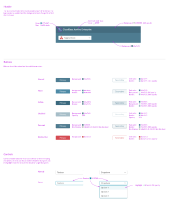-
Type:
New Feature
-
Resolution: Unresolved
-
Priority:
Major
-
Component/s: blueocean-plugin
-
Blue Ocean 1.2-beta3
Problem
It's currently difficult to make changes to the Blue Ocean CSS because it is compiled by the plugin when a release is prepared. Right now this makes the Blue Ocean CSS difficult to modify for theming purposes. Another plugin should be able to override any of the colors defined in `variables.less` to create a new "Theme" for Blue Ocean. It would also be nice if Blue Ocean made it easy to replace the logo with a custom logo.
Solution
- Make it easy to build the CSS based on of a primary brand color or two. Less allows you to define colors that have a relationship to with another. For example, the primary theme could define one color for the header (blue) and define the selection color to be a tint of the header (light blue). A derived theme could then specify it’s own header color (green) and the selection color would be automatically adjust to a tint of the header (light green). If colors are defined to have a relationship with each other it makes it easy for a theme to declare slight adjustments to the main theme without specifying all of the color values (which is harder to maintain as the base theme changes).
- Make it easy to replace the logo with a custom logo. The theme should be able to provide one image for the entire logo, or a logo mark and text (for example, CJE has a 24x24 pixel logo mark with the text “CloudBees Jenkins Enterprise”). The provided logo (or logo mark) could be a gif, PNG, SVG.
Example
I've attached an example theme showing how CloudBees Jenkins Enterprise modifies the Blue Ocean theme to make the header dark teal. The goal of this story is to make it easy for the a plugin to supply:
- A Logo mark
- Logo text (In this example: “CloudBees Jenkins Enterprise”)
- A header background color (In this example: #4e7c91)
And everything is adjusted automatically, including the buttons and the selection colors.
Our current approach for CJE accomplishes this by adding an additional stylesheet that adds rules to override the generated Blue Ocean CSS (bad approach). This is problematic because the CSS in the upstream Blue Ocean package can change without warning and we run the risk of having to re-theme components to get them to use the CloudBees theme.
It would be much easier if we could supply our own “variables.less” and the Blue Ocean CSS would be generated based on our own variables.
Technical Notes
- JDL and other plugins export the less rather than compiled CSS
- Blue Ocean compiles and serves less at runtime
- We can build a servlet or something based on lesscss-java
- is duplicated by
-
JENKINS-49081 Support for Simple Theme Plugin in Blue Ocean
-
- Closed
-
- links to
